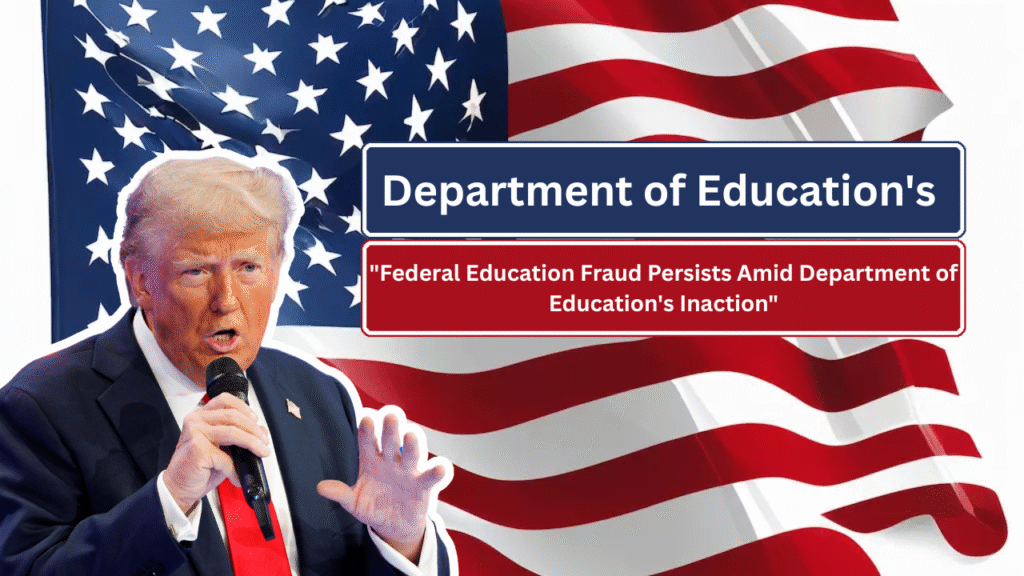The U.S. Department of Education (ED) is facing growing criticism for its limited response to widespread fraud affecting federal education programs. From fake student scams to pandemic-era food aid misuse, oversight failures are costing taxpayers hundreds of millions of dollars-while many believe the Department is not doing enough to detect or prevent fraud.
This article explores several major fraud incidents and highlights why education watchdogs and lawmakers are calling for greater transparency and reform.
Ghost Students Exploit Financial Aid Programs
One of the most alarming cases of fraud is occurring at California’s community colleges, where so-called “ghost students” have been using stolen identities and automated bots to enroll in online classes. Their goal? To fraudulently claim federal Pell Grants and California’s Cal Grants.
A 2024 report found that $13 million in state and federal aid was paid out to these fake students-a 74% increase in fraudulent activity over the previous year. Faculty and administrators noted that they were overwhelmed by suspicious activity, including strange enrollment patterns and fake assignments submitted by bots.
Despite attempts to tighten security, including ID verification and email authentication, fraudsters are finding new ways to bypass systems.
“We need coordinated action between states and the federal government,” said a California community college administrator. “Right now, it’s a patchwork effort, and taxpayers are footing the bill.”
Learn more about the Federal Pell Grant at: https://studentaid.gov/understand-aid/types/grants/pell
Massive Pandemic Food Aid Scam Goes Unchecked
In Minnesota, a nonprofit called Feeding Our Future defrauded the federal government out of more than $250 million intended for low-income children during the pandemic. The money came from the Federal Child Nutrition Programs, which are managed by the U.S. Department of Agriculture (USDA) but overseen at the state level by Departments of Education.
An audit revealed that the Minnesota Department of Education ignored multiple red flags, including inflated meal counts and suspicious vendor relationships. Over 70 people have been charged in the case, and dozens have already been convicted.
Despite the scale of the fraud, critics argue that ED failed to conduct proper oversight or intervene quickly—even as complaints surfaced.
More information about USDA Child Nutrition Programs: https://www.fns.usda.gov/cn
Oversight Team Cutbacks Raise Red Flags
In March 2025, the U.S. Department of Education eliminated nearly half of its workforce, including critical positions within its Vendor and Program Accountability Office. This office had been tasked with monitoring student loan servicers and ensuring they complied with federal rules.
Experts worry that cutting these roles leaves borrowers vulnerable and increases the risk of further fraud and servicing errors.
“This reduction in oversight couldn’t come at a worse time,” said a former department official. “With loan payments resuming and fraud on the rise, the Department should be increasing accountability, not cutting it.”
See more about student loan oversight: https://studentaid.gov/manage-loans/repayment/servicers
Department of Education’s Response: Too Little, Too Late?
In response to mounting criticism, ED announced the creation of a new Office of Enforcement under Federal Student Aid in late 2024. The office is tasked with investigating fraud and abuse by postsecondary institutions, especially those that take in federal aid but leave students with high debt and poor outcomes.
However, skeptics say this move is insufficient given the scope of recent scandals.
Meanwhile, Minnesota lawmakers approved the creation of a state Office of Inspector General within their Department of Education, which will be dedicated to investigating fraud, waste, and abuse in education-related federal programs.
Learn about the Office of Inspector General (OIG): https://oig.ed.gov
Lawmakers Call for Reform
Members of Congress have proposed several bills to strengthen education fraud detection. One bipartisan effort, the Education Integrity and Oversight Act, aims to:
- Increase funding for state and federal audits
- Require real-time fraud reporting from colleges and education vendors
- Modernize data systems to detect fraudulent applications faster
While the bill has support from both parties, it remains stalled in committee as of May 2025.
What’s at Stake?
The cost of inaction is high. Fraudulent education activity doesn’t just waste money-it undermines trust in federal programs that serve millions of students. And when the Department tasked with protecting taxpayer dollars cuts oversight teams or fails to act on red flags, critics say the system itself becomes vulnerable.
As tuition prices rise and student debt surpasses $1.7 trillion, the federal government must ensure every dollar is used for genuine educational needs-not handed to scammers exploiting the system.
Official Resources
If you’re a student, parent, or administrator concerned about fraud or seeking guidance, these official resources provide information and reporting tools:
- U.S. Department of Education
- Federal Student Aid Programs
- Office of Inspector General – Fraud Hotline
- USDA Child Nutrition Programs
Conclusion
From ghost students to misused food funds, fraud in federal education programs is both widespread and costly. While some reforms are underway, many critics argue that the Department of Education must do more to prevent abuse, protect vulnerable students, and preserve public trust.
Until then, taxpayers and students alike remain at risk in a system that too often fails to enforce its own rules.




